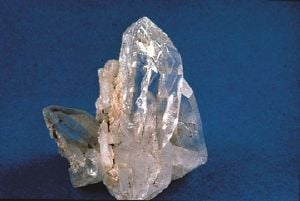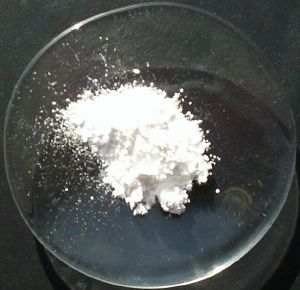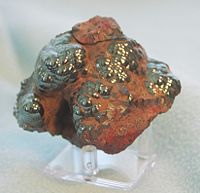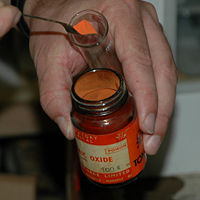Oxide
An oxide is a chemical compound consisting of molecules in which at least one oxygen atom is bonded to other elements. Most of the Earth's crust consists of oxides. Many oxides are produced when elements react with oxygen in the air. Several materials that are considered "pure elements" have an oxide coating. For example, aluminum foil has a thin skin of aluminum oxide (alumina, Al2O3) that protects the foil from further corrosion. The two principal oxides of carbon, carbon monoxide and carbon dioxide, are produced by the combustion of hydrocarbons. Water (H2O) may be considered an oxide of hydrogen.
Nomenclature
In the eighteenth century, oxides were named calxes or calces, after the calcination process used to produce oxides. Calx was later replaced by oxyd.
The name of an oxide is often based on the number of oxygen atoms in each molecule of the oxide. For example, an oxide containing only one oxygen atom per molecule is called an oxide or monoxide; an oxide containing two oxygen atoms per molecule is a dioxide; three oxygen atoms, trioxide; four oxygen atoms, tetroxide; and so on, following the Greek numerical prefixes.
Two other types of oxide are:
- peroxide, with the formula O22−; and
- superoxide, with the formula O2−.
In such species, oxygen is assigned oxidation states higher than that of oxide (which is 2-).
Properties of oxides
Oxides of more electropositive elements (particularly metals) tend to be basic, and they are called basic anhydrides. Upon adding water, they may form basic hydroxides. For example, sodium oxide is basic; when hydrated, it forms sodium hydroxide.
Conversely, oxides of more electronegative elements tend to be acidic. They are called acid anhydrides. Upon adding water, they form oxoacids. For example, dichlorine heptoxide is an acidic oxide; perchloric acid is a hydrated form.
In some cases, an oxide can behave as an acid or a base, under different conditions. They are called amphoteric oxides. An example is aluminum oxide. Other oxides do not behave as either acid or base.
The oxide anion (O2−) is the conjugate base of the hydroxide ion (OH−) and is encountered in an ionic solid such as calcium oxide. The O2− anion is unstable in aqueous solution—its affinity for H+ is so great (pKb ~ -22) that it extracts a proton from a solvent H2O molecule:
- O2− + H2O → 2 OH−
The oxides of chemical elements in their highest oxidation state are predictable and their chemical formulas can be derived from the number of valence electrons in the atoms of those elements. One exception is copper, for which the highest oxidation state oxide is copper(II) oxide and not copper(I) oxide. Another exception is fluoride that does not exist as expected as F2O7 but as OF2, with the least electronegative element given priority.[1]. Phosphorus pentoxide, the third exception, is properly represented by the chemical formula P4O10, not P2O5.
Ionic oxides form hydroxides in water
Although many anions are stable in aqueous solution, ionic oxides are not. For example, sodium chloride dissolves readily in water to give a solution containing Na+ and Cl- ions. Oxides do not behave like this. When an ionic oxide dissolves, each O2− ion become protonated to form a hydroxide ion. Although calcium oxide (CaO) is said to "dissolve" in water, the products include hydroxide ions:
- CaO + H2O → Ca2+ + 2 OH-
Concentrations of oxide ions in water are too low to be detectable with current technology.
Authentic soluble oxides do exist, but they release oxyanions, not O2-. Well-known soluble salts of oxyanions include sodium sulfate (Na2SO4), potassium permanganate (KMnO4), and sodium nitrate (NaNO3).
Common oxides sorted by oxidation state
- Element in (I) state
- Element in (II) state
- Aluminum monoxide (AlO)
- Barium oxide (BaO)
- Beryllium oxide (BeO)
- Cadmium oxide (CdO)
- Calcium oxide (CaO)
- Carbon monoxide (CO)
- Cobalt(II) oxide (CoO)
- Copper(II) oxide (CuO)
- Iron(II) oxide (FeO)
- Lead(II) oxide (PbO)
- Magnesium oxide (MgO)
- Mercury(II) oxide (Template:MercuryO)
- Nickel(II) oxide (NiO)
- Nitrogen oxide (NO)
- Palladium(II) oxide (PdO)
- Silver(II) oxide (AgO)
- Strontium oxide (SrO)
- Sulfur monoxide (SO)
- Tin(II) oxide (SnO)
- Titanium(II) oxide (TiO)
- Vanadium(II) oxide (VO)
- Zinc oxide (ZnO)
- Element in (III) state
- Aluminum oxide (Al2O3)
- Antimony trioxide (Sb2O3)
- Arsenic trioxide (As2O3)
- Bismuth trioxide (Bi2O3)
- Boron oxide (B2O3)
- Chromium(III) oxide (Cr2O3)
- Dinitrogen trioxide (N2O3)
- Erbium(III) oxide (Er2O3)
- Gadolinium(III) oxide (Gd2O3)
- Gallium(III) oxide (Ga2O3)
- Holmium(III) oxide (Ho2O3)
- Indium(III) oxide (In2O3)
- Iron(III) oxide (Fe2O3)
- Lanthanum(III) oxide (La2O3)
- Lutetium(III) oxide (Lu2O3)
- Nickel(III) oxide (Ni2O3)
- Phosphorus trioxide (P4O6)
- Promethium(III) oxide (Pm2O3)
- Rhodium(III) oxide (Rh2O3)
- Samarium(III) oxide (Sm2O3)
- Scandium(III) oxide (Sc2O3)
- Terbium(III) oxide (Tb2O3)
- Thallium(III) oxide (Tl2O3)
- Thulium(III) oxide (Tm2O3)
- Titanium(III) oxide (Ti2O3)
- Tungsten(III) oxide (W2O3)
- Vanadium(III) oxide (V2O3)
- Ytterbium(III) oxide (Yb2O3)
- Yttrium(III) oxide (Y2O3)
- Element in (IV) state
- Carbon dioxide (CO2)
- Cerium(IV) oxide (CeO2)
- Chlorine dioxide (ClO2)
- Chromium(IV) oxide (CrO2)
- Dinitrogen tetroxide (N2O4)
- Germanium dioxide (GeO2)
- Hafnium(IV) oxide (HfO2)
- Lead(I) peroxide (PbO2)
- Manganese(IV) oxide (MnO2)
- Nitrogen dioxide (NO2)
- Ozone (O3)
- Plutonium dioxide (PuO2)
- Ruthenium(IV) oxide (RuO2)
- Selenium dioxide (SeO2)
- Silicon dioxide (SiO2)
- Sulfur dioxide (SO2)
- Tellurium dioxide (TeO2)
- Thorium dioxide (Template:ThoriumO2)
- Tin dioxide (SnO2)
- Titanium dioxide (TiO2)
- Tungsten(IV) oxide (WO2)
- Uranium dioxide (UO2)
- Vanadium(IV) oxide (VO2)
- Zirconium dioxide (ZrO2)
- Element in (V) state
- Element in (VI) state
- Element in (VII) state
See also
Notes
- ↑ Emeric Schultz, "Fully Exploiting the Potential of the Periodic Table through Pattern Recognition," J. Chem. Ed. 82(2005): 1649.
ReferencesISBN links support NWE through referral fees
- Chang, Raymond. 2006. Chemistry, 9th ed. New York: McGraw-Hill Science/Engineering/Math. ISBN 0073221031 and ISBN 978-0073221038.
- Cotton, F. Albert, and Geoffrey Wilkinson. 1980. Advanced Inorganic Chemistry, 4th ed. New York: Wiley. ISBN 0471027758.
- McMurry, J., and R.C. Fay. 2004. Chemistry, 4th ed. Upper Saddle River, NJ: Prentice Hall. ISBN 0131402080.
Credits
New World Encyclopedia writers and editors rewrote and completed the Wikipedia article in accordance with New World Encyclopedia standards. This article abides by terms of the Creative Commons CC-by-sa 3.0 License (CC-by-sa), which may be used and disseminated with proper attribution. Credit is due under the terms of this license that can reference both the New World Encyclopedia contributors and the selfless volunteer contributors of the Wikimedia Foundation. To cite this article click here for a list of acceptable citing formats.The history of earlier contributions by wikipedians is accessible to researchers here:
The history of this article since it was imported to New World Encyclopedia:
Note: Some restrictions may apply to use of individual images which are separately licensed.



